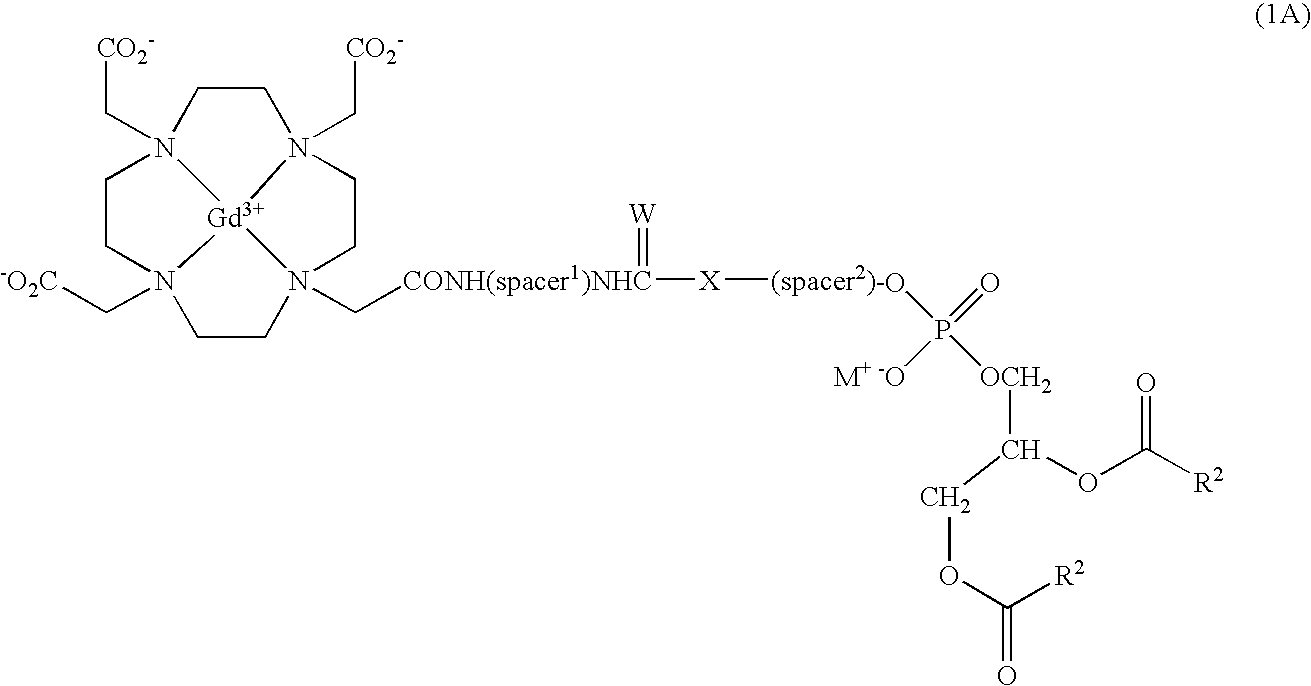Lipophilic derivatives of chelate monoamides
a technology of chelate monoamide and lipophilic derivatives, which is applied in the field of diagnostic compositions, can solve the problems of affecting the efficiency of the above described process, and the relaxation rate of the relevant hydrogen nuclei is too slow to generate detectable amounts of energy, so as to facilitate the excretion of paramagnetic ions, enhance the relaxation, and enhance the resonance image
- Summary
- Abstract
- Description
- Claims
- Application Information
AI Technical Summary
Benefits of technology
Problems solved by technology
Method used
Image
Examples
example 1
Synthesis of Amide Gd Ligand
[0128]Scheme 1 illustrates a synthetic scheme for preparing an amide containing ligand for gadolinium. As shown in Scheme 1, reaction of a suitable mono-protected diamine 1 (i.e., 1-(t-butoxycarbonylamino)-6-aminohexane) with a α-halo acetylhalide 2 in the presence of added base (i.e., i-Pr2NEt) gives the α-halo amide 3. Nucleophilic displacement of the α-halo amide with the macrocyclic tetramine 4 (i.e., 1,4,7,10-tetraazacyclododecane) gives the mono-functionalized macrocycle 5 in the presence of added base (i.e., i-Pr2NEt). Further alkylation of the remaining nitrogens in the macrocycle with α-halo-benzyl acetate, 6, in the presence of a suitable base (i.e., i-Pr2NEt) gives the tetrafunctional derivative 7. Removal of the t-butoxycarbonyl group with a suitable acid (i.e., trifluoroacetic acid) gives the amine 8 after neutralization.
[0129]Conversion of the amine 8 to its corresponding isocyanate is achieved by, first formation of the amine carbamate salt...
example 2
Introduction of Gadolinium Ion
[0132]Gadolinium ion may be introduced into the chelate either by initially metalating DOTA before or during the preparation of the compound of formula (1) or metalating after synthesis.
[0133]For example, premetalation of DOTA or DOTA′-CONR1 (spacer1) NR1H is carried out in aqueous solution using a stoichiometric amount of GdCl3. The reaction mixture is lyophilized to dryness and used without further purification prior to conjugation with PE or triglycyl-PE. As salts carried onto the final conjugation negatively affect the coupling chemistry, they are removed by aqueous rinses of the dried reaction mixture.
[0134]Gd2O3 may be used in place of GdCl3 to produce a “salt free” metal complex, by boiling the solution containing Gd2O3 for an extended period of time in MeOH / chloroform.
[0135]Postmetalation of the compound of formula (1) is carried out with GdCl3 in a chloroform methanol mixture with boiling or in anhydrous DMF.
example 3
Preparation of Emulsions
[0136]The conjugates of formula (1) are associated with nanoparticles prepared as in Preparation A. Each particle will contain approximately 33,000 Gd3+ chelates.
PUM
| Property | Measurement | Unit |
|---|---|---|
| atomic numbers | aaaaa | aaaaa |
| atomic numbers | aaaaa | aaaaa |
| atomic numbers | aaaaa | aaaaa |
Abstract
Description
Claims
Application Information
 Login to View More
Login to View More - R&D
- Intellectual Property
- Life Sciences
- Materials
- Tech Scout
- Unparalleled Data Quality
- Higher Quality Content
- 60% Fewer Hallucinations
Browse by: Latest US Patents, China's latest patents, Technical Efficacy Thesaurus, Application Domain, Technology Topic, Popular Technical Reports.
© 2025 PatSnap. All rights reserved.Legal|Privacy policy|Modern Slavery Act Transparency Statement|Sitemap|About US| Contact US: help@patsnap.com



